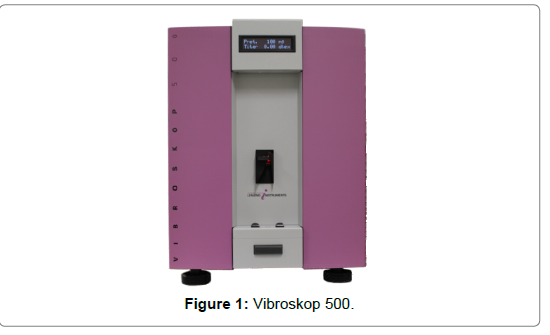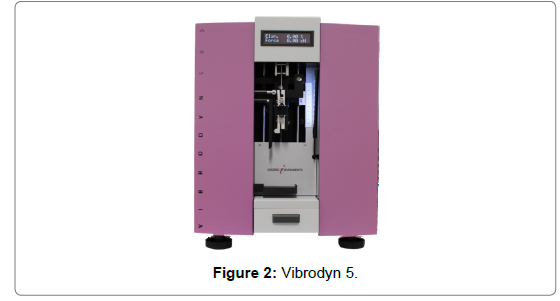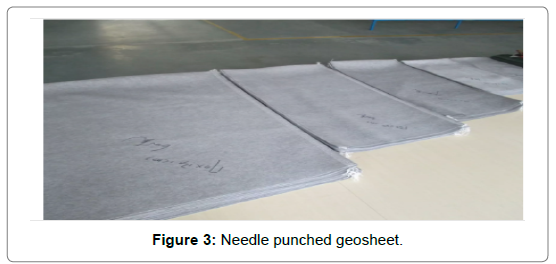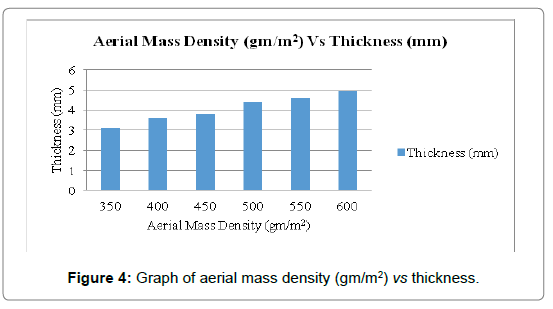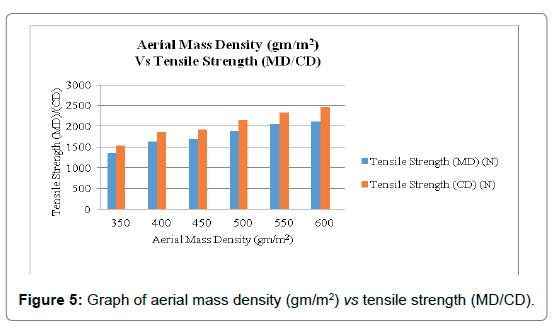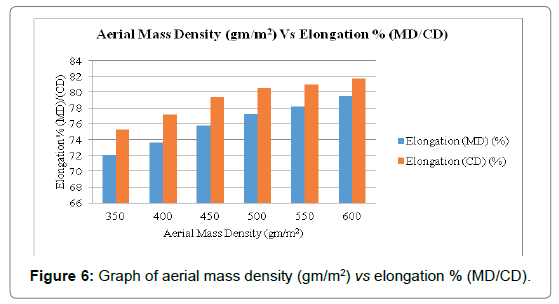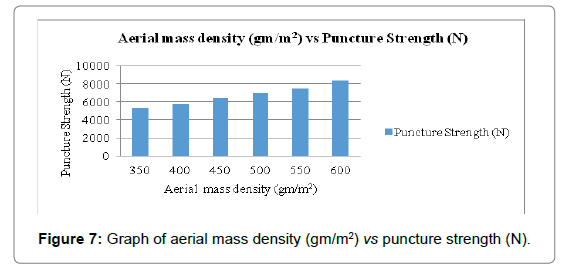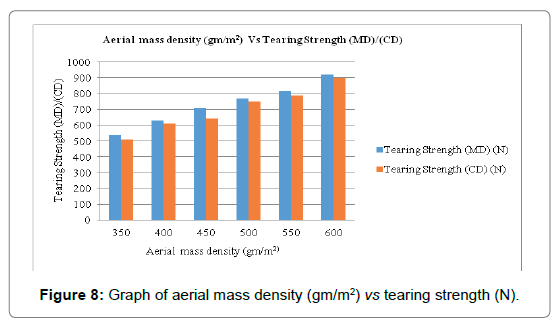Research Article, J Fashion Technol Textile Eng Vol: 9 Issue: 9
Optimization of Production Parameters for Manufacturing Polypropylene based Needle Punched Nonwoven Geosheet and Analysing Their Physical and Mechanical Properties
AKM Ashiqur Rahman Mazumdar1* and Motiur Rahman2
1Department of Fabric Engineering, Faculty of Textile Engineering, Bangladesh University of Textiles, Bangladesh
2Department of Fabric Engineering, Faculty of Textile Engineering, Bangladesh University of Textiles, Bangladesh
- *Corresponding Author:
- A K M Ashiqur Rahman Mazumdar
Department of Fabric Engineering, Faculty of Textile Engineering, Bangladesh University of Textiles, Bangladesh
E-mail: a.k.m.ashiq@butex.edu.bd
Received Date: August 16, 2021; Accepted Date: September 22, 2021; Published Date: September 29, 2021
Citation: Ashiqur Rahman Mazumdar AKM, Rahman M (2021) Optimization of Production Parameters for Manufacturing Polypropylene based Needle Punched Nonwoven Geosheet and Analysing Their Physical and Mechanical Properties. J Fashion Technol Textile Eng 9:9. 219.
Copyright: © All articles published in Journal of Fashion Technology & Textile Engineering are the property of SciTechnol, and is protected by copyright laws. “Copyright © 2021, SciTechnol, All Rights Reserved.
Abstract
Needle punched nonwoven geotextiles exhibit the best performance parameters compared to other structures when used in civil engineering applications, drainage, filtration, soil protection, erosion control, river bank protection, river training, coastal protection and providing reinforcement. Besides, the physical and mechanical characteristics significantly influence the performance & functionality of the product. There is a significant correlation between the mechanical properties of geo-textiles & their aerial mass. In this paper, different production parameters such as feed rate, needle penetration, stroke frequency has been optimized for manufacturing polypropylene based geosheet samples of different aerial mass which are used to produce geobags by stitching for sand filling and also their various properties has been analyzed.
Keywords: Geotextile; Geobag; Polypropylene; Needle punched; Geosheet
Introduction
Geosheet is generally a nonwoven geotextile composed of polyester, polypropylene or polyethylene, used to produce geobag which has better protection capacity than concrete blocks as underwater protection; greatly due to their instinctive filter properties and better launching behavior when underwater slope is under-scoured and improves the overall sustainability of riverbank protection works.The effect of fiber composition, mass per unit area and depth of needle penetration on tensile properties of polyesterviscose blended nonwoven geotextile is investigated and it is found that, increase in fabric weight and polyester content increases tensile resistance of fabrics. It was also found that depth of needle penetration has no significant effect on the tensile properties [1]. Tensile strength and puncture resistance increase with the increase of the aerial mass of the nonwovens, while the perforation diameter decrease with the increase of the aerial mass [2]. Needle penetration speed has an effect on geotextiles thickness and air permeability. Webs needled at higher speeds due to better coherency have higher tensile strengths in both the machine and cross directions [3]. Reorientation of the fibers from horizontal to vertical direction as a result of depth of needle penetration and stroke frequency decreases the transmissivity of geotextiles due to breakage of fibers, causing a significant reduction in large pores [4,5]. An increased depth of needle penetration resulted in deeper interlocking and entanglement of fibers and thus higher compaction, although when the depth of needle penetration was too deep it could lead to negative effects such as fiber breakage, which was related to the mechanics of tensile failure [6].
Regular PES fiber nonwoven geotextile has better resistance to static puncher than recycle PES fibers. It has also been represented that the geotextile made from polypropylene fibers has better values than the geo-textile made from regular polyester fibers [7]. A study shows that it was aimed at understanding the effect of testing speeds on the frictional properties of needle punched nonwoven substrates. Results indicate that as the speed of the testing increased, frictional resistance increased and the coefficient of friction decreases with the increase in applied normal loads. The installation procedures (which induce mechanical damage) and abrasion can cause unwanted changes on the properties of the geo-sheet [8]. Six hundred geo-bags made from geosheets were tested to evaluate the failure in terms of friction force, water depth, flow rate and bag aging. An investigation of the effect of geobag aging represents that 52% of saturated geobags yield weight in the range 0 to 5% and about 70% of initially dry bags yield weight in the range 10 to 20% [9]. Due to long term service of geo-bag the properties of geotextile materials could be predicted using empiric models, finite model theory, and composite material theory, using computer prediction models of nonwoven textile stretching and also using mechanical models. Mechanical properties of needle punched nonwoven geotextile substances depend on their structural design, and also on technological conditions during production process. Thereby, the most important roles are played by the structural mechanical properties of fibers, fiber orientation, geo-textile surface mass and parameters of the needling process [10]. The more the GSM of geobags is, the more its stability is due to less thickness variation and retaining its tensile strength as well as dimensional structure after using geobags around six months when higher GSM is used [11]. The performance of geo-bags revetment are more stable than bags of lower mass under high water velocity and in incipient motion test failure mechanism initiated at a water flow velocity of 2.9 m/s. Conveyance Estimation system (CES) was used to extend the laboratory measured hydraulic parameters to predict mobile bed formation for different water depth after performing fixed bed experimental observation. The CES model helps in characterizing bed changes against different water depth in revetment failure and develop much needed geo bag revetment design guidance [12]. Success of geo-bag revetment is dependent on the geobags remaining stable under current loading. Geobags have a range of fill percentage which optimizes the stability of the elements. Bags with lower fill percentage appears less stable than those of higher fill percentage because internal sand movement within the bags [13].
Materials and Methods
Materials
Fibers used: Nonwoven webs are made from polypropylene fibers. Polypropylene granules obtained from Tasnee, Saudi Arabia are used to produce synthetic polypropylene fibers. Polypropylene fibers are used as raw material to prepare the nonwoven samples due to its cheap price and conformity of fibers to production methods. It exhibits excellent chemical resistance to acids and alkalis at ambient temperatures, have an exceptionally low moisture absorption such that the action of water at ambient temperature has no effect on their mechanical characteristics and are resistant to microorganisms, insects and the growth of mildew or fungi. Two color (White and Black) fibers are used to produce nonwoven fabrics where the ratio of white to black fibers is 88:12. The properties of polypropylene fibers are tested by VIBROSKOP 500 and VIBRODYN 500 shown in Table 1 below Figures 1 and 2.
| Properties | Value |
|---|---|
| Linear density | 6 denier |
| Staple Length | 90 mm |
| Elongation at break | 84.31% |
| Tenacity | 5.33 g/den |
| Young Modulus | 31.36 g/den |
| Work of Rupture | 17.69 g*cm |
| Crimp per inch | 10 |
| *TCF= Thibeau Chute Feed *NP= Needle Penetration *SF=Stroke Frequency *st/min=Strokes/minute | |
Table 1: Properties of polypropylene fiber sample.
Methods
Preparation of test specimen: Nonwoven fabric samples for geosheet are produced on a ANDRITZ needle punch production line machines. Nonwoven webs are made from polypropylene fibers. White and Black polypropylene fibers are fed to the needle punching line LAROCHE feed system. There are three feeders in which feeder 1 & feeder 3 feed white polypropylene fibers whereas feeder 3 feed black polypropylene fibers to weighing bale opener. After opening the fibers are laying on horizontal opener in a manner of sandwich where black fibers are laying in between two white fibers layers. In Thibeau Metering Silo (TMS) fibers are supermix and blend for uniformity. The Thibeau Chute Feed (TCF) card feeders and the Thibeau Metering Silo (TMS) combindly ensure the feeding of the fibers up to 90 mm staple length. Both participate to the final opening for the constant amount of fiber in feed to the card. In carding machine, the fibers are aligned parallel and uniformly distributed web produce. The web is then transported to the cross lapper. The purpose of this section is to lay down the carded web to the desired width. It helps to build up the desired weight by controlling number of layers. A benefit of having multiple layers is increased uniformity since heavy or light areas in the individual webs tend to be evened out in multiple layers (Figure 3). Then the webs were fed into the needle loom. There were two needle looms used in ANDRITZ production section. The fibers in the web are entangled by top needle in upper surface at first needle loom and then drafted by ZETA drafter go through second needle loom bottom surface fibers are bonded from bottom punching. The needle loom- 1 contains 93600 needles (divided into three needle boards forming an entangled pattern) with the technical specification 15×30×38×3.5 whereas the needle loom-2 contains 84000 needles (divided into two needle board) with the technical specification 15×18×38×3. Different needle punched nonwoven samples are produced with polypropylene fibers with aerial mass of 350 GSM, 400 GSM, 450 GSM, 500 GSM, 550 GSM, 600 GSM used to perform this study. These samples are identified as G1, G2, G3, G4, G5 and G6 respectively. The actual parameters for each run are shown in Table 2.
| Sample Code | Aerial Mass Density | TCF Rate (gm/m²) | Cross Lapping | Needle Loom-1 | Needle Loom-2 | ||
|---|---|---|---|---|---|---|---|
| (GSM) | NP (mm) | SF (st/min) | NP (mm) | SF (st/min) | |||
| G1 | 350 | 53 | 7 | 16 | 113 | 14 | 144 |
| G2 | 400 | 63 | 7 | 15 | 114 | 13 | 146 |
| G3 | 450 | 67 | 7 | 15 | 114 | 13 | 146 |
| G4 | 500 | 68 | 8 | 14 | 115 | 11 | 148 |
| G5 | 550 | 72 | 8 | 14 | 115 | 11 | 148 |
| G6 | 600 | 72 | 9 | 13 | 116 | 10 | 151 |
Table 2: Actual parameters for each Sample.
Test methods
Test standards (Table 3).
| Test type | Test standards |
|---|---|
| Tensile Strength | ASTM D4632 [16] |
| Trapezoid Tearing strength | ASTM D4533 [17] |
| Thickness test | EN ISO 9863-1 [18] |
| Static Puncture (CBR) test | EN ISO 12236 [19] |
Table 3: Test standards.
Results and Discussion
Physical properties
Thickness test result: The test results of sample thickness are shown in (Table 4 and Figure 4) shows the changes of thickness with aerial mass density (gm/m2). Thickness will increase more or less linear way with the increase of aerial mass density (gm/m2). Feed rate is increased to increase aerial mass density (gm/m2). So, to contain more fiber per area thickness will automatically increase. Here we get minimum thickness of 3.11 mm for 350 GSM (gm/m2) and maximum thickness of 4.94mm for 600 GSM (gm/m2).
| Sample Code | Aerial Mass Density (gm/m2) | Thickness (mm) |
|---|---|---|
| G1 | 350 | 3.11 |
| G2 | 400 | 3.6 |
| G3 | 450 | 3.79 |
| G4 | 500 | 4.39 |
| G5 | 550 | 4.58 |
| G6 | 600 | 4.94 |
Table 4: Results of thickness test of geosheet of different aerial mass density.
Mechanical properties
Tensile strength and elongation (%): The Tensile Strength is tested in Grab method. Test results are shown in Table 5. Figure 5 shows the changes of tensile strength at cross direction with changes of aerial mass density (gm/m2). Tensile strength at cross direction increases more or less linear way with the increase of aerial mass density (gm/m2). Here we have gotten minimum tensile strength of 1545.2N for 350GSM (gm/m2) and maximum tensile strength of 2468.3N for 600 GSM (gm/m2) in machine direction.It is noticed that tensile strength at cross direction is higher than machine direction. It is also expected that tensile strength in cross machine direction would be higher than the corresponding strength in the machine direction. These differences due to the orientation of the fibers attained in the formation of the fiber web. The predominant orientation of the fibers in the transverse direction of the web increases the probability of formation of joined bundles, which results in uniform distribution of the load and increases the strength of the material. This defectiveness of the bonds among the individual bundles in the longitudinal direction of the nonwoven geotextiles is due to the mechanical stress concentration, which decreases the strength in this direction. It happens because more numbers of fiber are laid and oriented in the cross direction in the cross-lapped web, which resists the external load [14,15].
| Sample Code | Tensile Strength (MD) (N) |
Tensile Strength (CD) (N) |
Elongation (MD) (%) |
Elongation (CD) (%) |
|---|---|---|---|---|
| G1 | 1342.6 | 1545.2 | 72.1 | 75.3 |
| G2 | 1632.2 | 1850 | 73.6 | 77.2 |
| G3 | 1703 | 1922.4 | 75.8 | 79.4 |
| G4 | 1894.6 | 2141.7 | 77.3 | 80.5 |
| G5 | 2047.4 | 2330.2 | 78.2 | 81 |
| G6 | 2103.8 | 2468.3 | 79.5 | 81.7 |
| *MD= Machine Direction *CD= Cross Direction | ||||
Table 5: Result of tensile strength test of geosheet of different aerial mass density.
Among the properties, elongation is not changing linearly with the aerial mass density (gm/m2). Elongation is around 75% of all aerial mass density (gm/m2). With the increase in mass per unit area of nonwoven, the number of fibers in the fabric increases, the fibers become closer to each other leading to increasing cohesive forces between fibers. It is expected that due to the unevenness i. e. less fiber orientation and entanglement of needle punched nonwoven, elongation is less and the result is fluctuated. Figure 6 shows the change of elongation at machine direction with the increase of aerial mass density (gm/m2). Elongation is not increasing linear way as other properties. Elongation is changing inconsistently with the aerial mass density (gm/m2). It may be due to the variation of fiber distribution in the web and cross lapping. It is unpredictable to guess what would be the value if the aerial mass density (gm/m2) is increased or reduced. We got elongation for 400 GSM (gm/m2) is 73.6% where for 550 the value is 72.2%. Figure 6 shows the change of elongation at cross direction with the increase of aerial mass. Elongation at cross direction also is changing inconsistently with the aerial mass density (gm/m2). It may be due to the variation of fiber distribution in the web and cross lapping. We got elongation for 400 GSM (gm/m2) is 71.2% where for 550 the value is 75.8%.
Though elongation % is not consistent, elongation at cross direction is higher than machine direction for most of the cases. This is because less numbers of fibers are laid and oriented in the machine direction in the cross-lapped web, which will decrease cohesive forces between fibers, thus enhancing sliding over effect when the external load is applied. The orientation of the fibers in cross direction more parallel and attained in mechanical formation of the fiber web.
Puncture strength: Table 6 shows us the puncture strength of different geobag of different aerial mass density (gm/m2). Puncture strength is around 4 times higher than tensile strength of geo-bag. How puncture strength is changing with the change of aerial mass which is shown in Figure 7 by using graphical representation.Puncture strength is so much greater than tensile strength of nonwoven geobag. This is because fibers are breaking in all direction at a time rather than one direction either MD or CD. Figure 7 shows the change and a good correlation of puncture strength with the change of GSM. Puncture strength is increasing linear way with little variance with the increase of aerial mass density (gm/m2).
| Aerial mass density (gm/m2) | Puncture Strength (N) |
|---|---|
| 350 | 5369.8 |
| 400 | 5728 |
| 450 | 6436 |
| 500 | 7027.8 |
| 550 | 7460 |
| 600 | 8356.6 |
Table 6: Results of puncture strength of geosheet of different aerial mass density (gm/m2).
Trapezoid tearing strength: Figure 8 shows the change of tearing strength at machine direction with the increase of aerial mass density (gm/m2). We have found 540N tearing strength for 350 GSM (gm/m2) where 920N for 600GSM (gm/m2). Figure 8 also shows the change of tearing strength at cross direction with the increase of GSM. Tearing strength at cross direction is changing like at machine direction. But the value is lower at cross direction than machine direction (Table 7). The behavior of geobag in tearing strength at machine direction is higher than cross direction. This is because more numbers of fibers are laid and oriented in the cross direction in the cross-lapped web, which increase cohesive forces between fibers, this is due to the fact that increased number of fibers increases friction between fibers and prevents fiber slippage and movements and thus enhancing sliding over effect when the external load is applied to tear the fibers in machine direction the entangled highly oriented fiber in cross direction resulting in an increase in the tear strength.
| Sample Code | Tearing Strength (N) (MD) (N) |
Tearing Strength (N) (CD) (N) |
|---|---|---|
| G1 | 540 | 510 |
| G2 | 630 | 610 |
| G3 | 710 | 640 |
| G4 | 770 | 750 |
| G5 | 815 | 790 |
| G6 | 920 | 900 |
Table 7: Results of trapezoid tearing strength of geosheet of different aerial mass density (gm/m2).
Conclusion
In this study, A series of needle punched nonwoven geobag are produced by varying the process parameters, i.e. TCF rate to card, number of cross lapping, depth of needle penetration and stroke frequency. The effect of these parameters has been investigated on the aerial mass density of geosheet. The role of process parameters (TCF rate to card, number of cross lapping) and their influence on aerial mass density of final product are discovered. It is found that there is a good correlation between process parameters and aerial mass density. That means increasing of these parameters increase the aerial mass density of geosheet and also the parameters were optimized to get the product of required aerial mass density.The influence of aerial mass density in the physical and mechanical properties of needle punched nonwoven geobag have been discussed. There is good linear correlation between aerial mass and thickness. Increasing aerial mass of geobag increases the thickness of geobag and vice versa.The influence of the aerial mass in the mechanical properties including tensile strength, puncture strength and trapezoid tear strength has been studied. Significant linear correlations between aerial mass density of the nonwoven and these mechanical properties have been found. Tensile strength, puncture strength and tear strength increase with the increase of the aerial mass of the nonwovens, these results may be explained by the increase of the amount of fibers in the nonwoven cross-section as the aerial mass increases.
References
- Dhange VK, Kadole P V (2018) A study of tensile properties of needle punched nonwovens. Man-Made Text 46: 196-200.
- Fangueiro R, Carvalho R, Soutinho H F C (2011) Mechanical properties of needle-punched nonwovens for geotechnical applications. In International Conference on Engineering UBI2011, Covilha, Portugal7: 4-10.
- Ramkumar S S, Roedel C (2003) Study of needle penetration speeds on frictional properties of nonwoven webs: A new approach. J Appl Polym Sci 89: 3626-3631.
- Jamshidi J (2015) Optimization of production parameters of geotextiles used for shoreline protection.Res J Text Appar 19:9-15.
- Rawal A, Anandjiwala R (2006) Relationship between process parameters and properties of multifunctional needle punched geotextiles. J Ind Text35: 271-285.
- Anandjiwala R D, Boguslavsky L (2008) Development of needle-punched nonwoven fabrics from flax fibers for air filtration applications. Text Res J 78: 614-624.
- Đorđić D, Stepanović J, Trajković D (2016) The analysis of the puncture strength of nonwoven geotextile materials made from polyester and polypropylene fibres. Adv Technol 5: 87-91.
- Ramkumar SS, Umrani A S, Shelly D C, Tock R W, Parameswaran S, et al. (2004) Study of the effect of sliding velocity on the frictional properties of nonwoven fabric substrates. Wear 256: 221-225.
- Akter A, Wright G, Crapper M, Pender G (2009) Failure Mechanism in Geobag Structure. Water Resour Hydraul Hydrol 1: 25-30.
- Stepanovic J M, Trajkovic D, Stojiljkovic D, Djordjic D (2016) Predicting the behavior of nonwoven geotextile materials made of polyester and polypropylene fibers. Text Res J 86: 1385-1397.
- Mhasavekar U P, Joshi R N (2017) A Practical Approach for Controlling Erosion of River Banks Using Needle Punched Geo-Bags: 1-5.
- Akter A, Pender G, Wright G, Crapper M (2013) Performance of a geobag revetment. I: quasi-physical modeling. J Hydraul Eng 139: 865-876.
- Thompson A, She Y, Oberhagemann K (2020) Geobag stability for riverbank erosion protection structures: Numerical model study. Geo text Geomembr 48: 703-712.
- Rawal A, Anand S, Shah T (2008) Optimization of parameters for the production of needle punched nonwoven geotextiles. J Ind Text 37: 341-356.
- AnenkovaI N, BokovaE S, Dedov A V (2011) Evaluation of the mechanical characteristics of needle-punch materials. Fibre Chem 42: 385-387
 Spanish
Spanish  Chinese
Chinese  Russian
Russian  German
German  French
French  Japanese
Japanese  Portuguese
Portuguese  Hindi
Hindi 